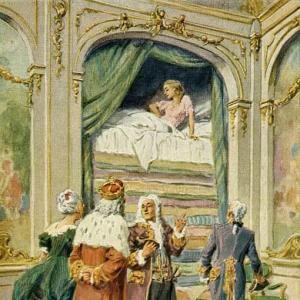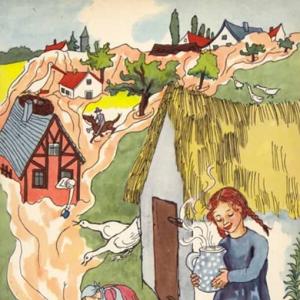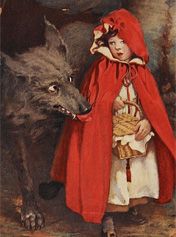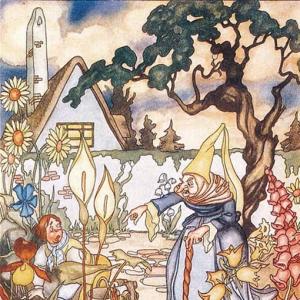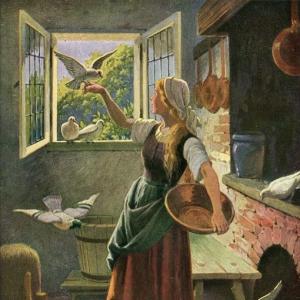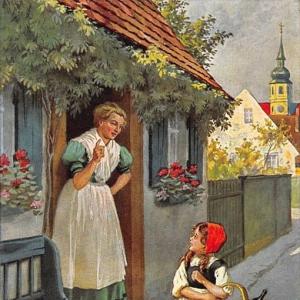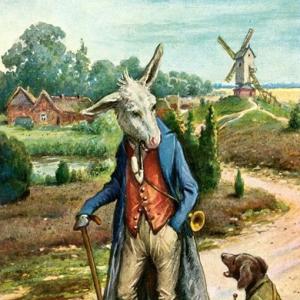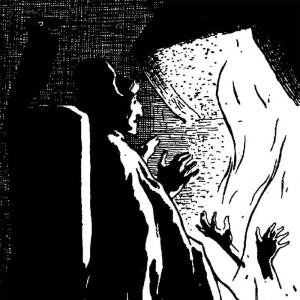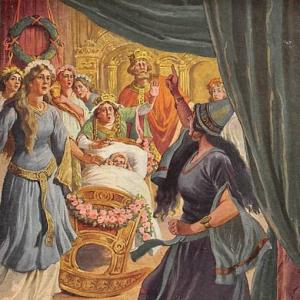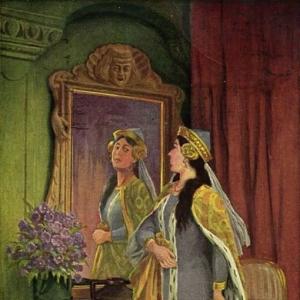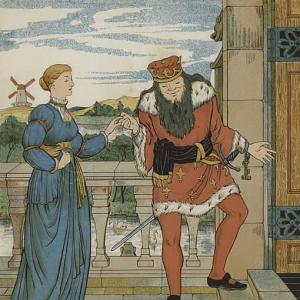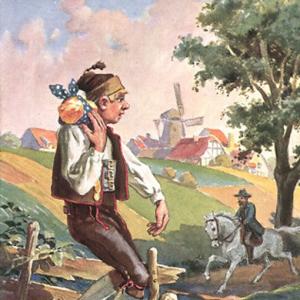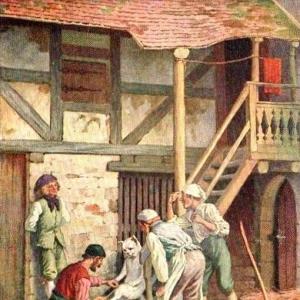Reading time for children: 7 min
A long time ago, there lived an old poet, a thoroughly kind old poet. As he was sitting one evening in his room, a dreadful storm arose without, and the rain streamed down from heaven; but the old poet sat warm and comfortable in his chimney-comer, where the fire blazed and the roasting apple hissed.
„Those who have not a roof over their heads will be wetted to the skin,“ said the good old poet.
„Oh let me in! Let me in! I am cold, and I’m so wet!“ exclaimed suddenly a child that stood crying at the door and knocking for admittance, while the rain poured down, and the wind made all the windows rattle.
„Poor thing!“ said the old poet, as he went to open the door. There stood a little boy, quite naked, and the water ran down from his long golden hair. He trembled with cold, and had he not come into a warm room he would most certainly have perished in the frightful tempest.
„Poor child!“ said the old poet, as he took the boy by the hand. „Come in, come in, and I will soon restore thee! Thou shalt have wine and roasted apples, for thou art verily a charming child!“
And the boy was so really. His eyes were like two bright stars; and although the water trickled down his hair, it waved in beautiful curls. He looked exactly like a little angel, but he was so pale, and his whole body trembled with cold. He had a nice little bow in his hand, but it was quite spoiled by the rain, and the tints of his many-colored arrows ran one into the other.
The old poet seated himself beside his hearth, and took the little fellow on his lap. He squeezed the water out of his dripping hair, warmed his hands between his own, and boiled for him some sweet wine. Then the boy recovered, his cheeks again grew rosy, he jumped down from the lap where he was sitting, and danced round the kind old poet.
„You are a merry fellow,“ said the old man. „What’s your name?“
„My name is Cupid,“ answered the boy. „Don’t you know me? There lies my bow. It shoots well, I can assure you! Look, the weather is now clearing up, and the moon is shining clear again through the window.“
„Why, your bow is quite spoiled,“ said the old poet.
„That were sad indeed,“ said the boy, and he took the bow in his hand -and examined it on every side. „Oh, it is dry again, and is not hurt at all. The string is quite tight. I will try it directly.“ And he bent his bow, took aim, and shot an arrow at the old poet, right into his heart. „You see now that my bow was not spoiled,“ said he laughing; and away he ran. The naughty boy, to shoot the old poet in that way. He who had taken him into his warm room, who had treated him so kindly, and who had given him warm wine and the very best apples!
The poor poet lay on the earth and wept, for the arrow had really flown into his heart. „Fie!“ said he. „How naughty a boy Cupid is! I will tell all children about him, that they may take care and not play with him, for he will only cause them sorrow and many a heartache.“
And all good children to whom he related this story, took great heed of this naughty Cupid; but he made fools of them still, for he is astonishingly cunning. When the university students come from the lectures, he runs beside them in a black coat, and with a book under his arm. It is quite impossible for them to know him, and they walk along with him arm in arm, as if he, too, were a student like themselves; and then, unperceived, he thrusts an arrow to their bosom. When the young maidens come from being examined by the clergyman, or go to church to be confirmed, there he is again close behind them. Yes, he is forever following people. At the play, he sits in the great chandelier and burns in bright flames, so that people think it is really a flame, but they soon discover it is something else. He roves about in the garden of the palace and upon the ramparts: yes, once he even shot your father and mother right in the heart. Ask them only and you will hear what they’ll tell you. Oh, he is a naughty boy, that Cupid. You must never have anything to do with him. He is forever running after everybody. Only think, he shot an arrow once at your old grandmother! But that is a long time ago, and it is all past now. However, a thing of that sort she never forgets. Fie, naughty Cupid! But now you know him, and you know, too, how ill-behaved he is!
 Learn languages. Double-tap on a word.Learn languages in context with Childstories.org and Deepl.com.
Learn languages. Double-tap on a word.Learn languages in context with Childstories.org and Deepl.com.Backgrounds to fairy tale „The naughty boy“
„The Naughty Boy“ is a brief, humorous fairy tale by Danish author Hans Christian Andersen, first published in 1835. This story is quite different from Andersen’s other fairy tales, as it is a witty and satirical piece that pokes fun at human nature and relationships.
Background and Origins:
Literary influences: Unlike many of Andersen’s stories, which were influenced by traditional folktales and legends, „The Naughty Boy“ is a more original creation. The tale demonstrates Andersen’s versatility as a writer, showcasing his ability to create not only emotional and moralistic stories but also light-hearted and humorous ones.
Personal experiences: Andersen’s own experiences may have inspired certain aspects of „The Naughty Boy.“ Throughout his life, Andersen was known for his wit and humor, which he employed in his letters and conversations. This story may reflect his observations of human behavior and relationships, as well as his own experiences with love and heartache.
Parody: „The Naughty Boy“ can be seen as a parody of traditional love stories and courtship, as it humorously explores the trials and tribulations of a love-struck Cupid who is tormented by a naughty young boy. The tale’s playful tone and satirical elements set it apart from Andersen’s more earnest and emotional fairy tales.
Social commentary: The story offers a light-hearted critique of human behavior, particularly the way people can become infatuated or obsessed with love, only to be hurt or disappointed in the end. The naughty boy’s actions can be interpreted as a metaphor for the unpredictable and sometimes painful nature of love.
While „The Naughty Boy“ may not be as well-known or celebrated as some of Andersen’s other fairy tales, it remains an entertaining and thought-provoking example of his storytelling prowess, highlighting his ability to find humor and insight in even the most seemingly mundane aspects of life.
Interpretations to fairy tale „The naughty boy“
„The Naughty Boy“ by Hans Christian Andersen is a short, light-hearted tale that contains several interpretations and insights into human behavior, love, and relationships. Some key interpretations of the story include:
The unpredictable nature of love: The tale humorously explores the trials and tribulations of a love-struck Cupid who is tormented by a naughty young boy. The boy’s actions can be seen as a metaphor for the unpredictable and sometimes painful nature of love, as even the god of love himself is not immune to heartache and disappointment.
Satire and parody: „The Naughty Boy“ can be viewed as a parody of traditional love stories and courtship, poking fun at the conventions of romantic narratives. The story serves as a reminder not to take love too seriously and to maintain a sense of humor in the face of life’s challenges.
Human folly and obsession: The story highlights the folly of human obsession with love and the lengths people will go to in pursuit of it. Cupid’s comical plight serves as a reminder that even the most powerful beings can fall victim to infatuation and become vulnerable to the whims of others.
The power of laughter: Throughout the tale, the naughty boy’s laughter causes Cupid great distress, but it also has the power to heal the god’s wounds. This can be interpreted as a commentary on the importance of laughter and humor in overcoming adversity and finding resilience in the face of life’s challenges.
The complexity of human relationships: The story touches upon the complexity of human relationships, as Cupid struggles to navigate the challenges posed by the naughty boy. The tale highlights the importance of patience, understanding, and maintaining a sense of humor when dealing with the intricacies of human interactions.
Overall, „The Naughty Boy“ offers a light-hearted and humorous exploration of human behavior, love, and relationships. Its playful tone and satirical elements provide a unique perspective on the subject matter, encouraging readers to reflect on the unpredictability of love and the value of humor in navigating life’s challenges.
Adaptions of the fairy tale „The naughty boy“
„The Naughty Boy“ by Hans Christian Andersen is a lesser-known fairy tale, and as such, it has not been adapted as frequently as some of his other works. However, there have been a few adaptations of this humorous story:
Literature: „The Naughty Boy“ has been included in various collections of Andersen’s fairy tales, both in its original form and in retellings. Some children’s books have adapted the story to make it more accessible and engaging for young readers, often featuring illustrations to bring the tale to life.
Animation: The story has been adapted in the form of short animations or as a segment in animated anthologies of Andersen’s fairy tales. For example, the Russian animation studio Soyuzmultfilm produced a series of short animated films based on Andersen’s works, including „The Naughty Boy.“
Audio Recordings: „The Naughty Boy“ has been adapted into audiobooks and radio plays, allowing listeners to enjoy the story in an auditory format. Some narrators have added their own unique interpretations and voices to bring the characters to life.
Stage Performances: Although less common, the story has been adapted for stage performances, either as a standalone piece or as part of a larger tribute to Andersen’s works. These adaptations often involve creative interpretations of the story, bringing out its humor and charm.
While „The Naughty Boy“ may not have as many adaptations as some of Andersen’s more famous fairy tales, the story’s wit and humor continue to entertain audiences and inspire creative retellings across various media formats.
Adaptions of the fairy tale „The naughty boy“
„The Naughty Boy“ by Hans Christian Andersen has inspired several adaptations in different forms of media, including:
Theater productions: „The Naughty Boy“ has been adapted for the stage in various productions. For example, in 2012, the Open Air Theater in London staged a production of „The Little Mermaid and Other Tales,“ which included a performance of „The Naughty Boy.“
Animated films: „The Naughty Boy“ has been adapted into several animated films, including a 1956 Soviet film titled „The Naughty Boy“ and a 1975 Czechoslovakian film titled „The Naughty Boy and the Robber.“
Children’s books: „The Naughty Boy“ has been adapted into several children’s books, including a 2014 picture book adaptation by John Cech and illustrated by Martin Hargreaves.
Radio plays: „The Naughty Boy“ has been adapted into several radio plays, including a 2017 adaptation by BBC Radio 4.
Music: „The Naughty Boy“ has also inspired musical adaptations, including a song by the British indie rock band The Delgados, which appears on their 2000 album „The Great Eastern.“
These adaptations often reinterpret or expand upon the themes of the original story, and may cater to different audiences depending on the medium and format of the adaptation.
Summary of the plot
„The Naughty Boy“ is a short and humorous fairy tale by Hans Christian Andersen. The story features a young Italian boy who causes trouble for Cupid, the god of love.
The tale begins with the ancient Greek poet Anacreon, who introduces Cupid as a mischievous but powerful god. Cupid, armed with his bow and arrows, has the ability to make people fall in love. One day, Cupid decides to visit Italy, where he encounters a young boy who is even more mischievous than himself.
The naughty boy takes great delight in tormenting Cupid, causing the god of love no end of trouble. The boy torments Cupid by shooting pea-shooters at him and laughing at his misfortune. This laughter has the power to heal Cupid’s wounds, yet it also causes him great embarrassment and distress.
Throughout the story, the naughty boy’s antics expose the vulnerability and foolishness of Cupid, who is typically seen as an all-powerful and influential figure. The tale is a light-hearted and comical exploration of love, human relationships, and the power of laughter.
In conclusion, „The Naughty Boy“ is a playful and witty fairy tale that highlights the unpredictable nature of love and the importance of humor in overcoming life’s challenges. The story serves as a reminder not to take love too seriously and to maintain a sense of humor in the face of adversity.
—————
Backgrounds to fairy tale „The naughty boy“
„The Naughty Boy“ is a lesser-known fairy tale by Danish author Hans Christian Andersen, who is famous for his classic stories such as „The Little Mermaid,“ „The Ugly Duckling,“ and „The Emperor’s New Clothes.“ Andersen was born on April 2, 1805, in Odense, Denmark, and died on August 4, 1875, in Copenhagen. Throughout his life, he published numerous collections of fairy tales and stories, which have been translated into more than 150 languages and have captivated generations of readers around the world.
Andersen’s fairy tales often contain moral lessons and explore various themes, such as love, innocence, beauty, and human nature. „The Naughty Boy“ is no exception, as it delves into the complexities of love and trust, as well as the duality of human nature. Although the story features the mythological figure Cupid, the god of love, it is primarily a cautionary tale that uses this character to illustrate the unpredictable and mischievous aspects of love.
Andersen’s unique storytelling style combines elements of realism and fantasy, creating a world where ordinary people encounter extraordinary events and creatures. In „The Naughty Boy,“ the old poet, a seemingly ordinary character, finds himself at the mercy of Cupid’s whims, highlighting the fantastical element of the tale. This combination of realism and fantasy has become one of the hallmarks of Andersen’s work, contributing to the enduring appeal of his stories.
Interpretations to fairy tale „The naughty boy“
„The Naughty Boy“ can be interpreted in several ways, offering different insights into the themes of love, trust, and human nature.
Love’s unpredictable nature: The story highlights the unpredictable and uncontrollable nature of love. Just like Cupid’s mischief, love can strike anyone at any time, often causing emotional turmoil and heartache. The story suggests that people should be cautious when dealing with love, as it can be both a source of joy and pain.
The duality of human nature: Cupid’s character embodies both innocence and mischief, symbolizing the duality of human nature. The story demonstrates that people are capable of both kindness and cruelty, and that appearances can be deceiving. This theme encourages readers to be cautious when trusting others, as their intentions may not always be clear.
The transformative power of love: The old poet’s decision to warn children about Cupid can be seen as a metaphor for the transformative power of love. The poet’s experience with Cupid changes him, making him more cautious and skeptical about love. This change reflects the way that love can impact and transform people’s lives in various ways.
The resilience of love: Despite the old poet’s efforts to warn others about Cupid, the mischievous god continues to cause heartache and sorrow. This persistence can be interpreted as a testament to the resilience and enduring nature of love. No matter how much people try to avoid or control it, love will always find a way to affect their lives.
The power of storytelling: The old poet uses storytelling as a means to communicate the dangers of Cupid and to educate others about the potential consequences of love. This highlights the power of stories to teach valuable life lessons, impart wisdom, and influence the way people perceive the world around them.
Summary of the plot
„The Naughty Boy“ is a fairy tale by Hans Christian Andersen that tells the story of a kind-hearted old poet who provides shelter to a little boy named Cupid during a stormy night. As the rain pours down, the poet brings the shivering boy into his warm room, dries his wet clothes, and gives him wine and roasted apples to help him recover. The boy, whose eyes sparkle like stars and whose hair curls beautifully, introduces himself as Cupid, the god of love.
Cupid’s bow and arrows appear to be damaged by the rain, but he soon discovers that they are still functional. To prove it, he shoots an arrow straight into the heart of the old poet who had just saved his life. Cupid laughs and runs away, leaving the old poet heartbroken and in pain.
The old poet decides to warn all good children about Cupid’s mischief and deceit, urging them to be cautious around him. However, Cupid continues to cause heartache and sorrow by disguising himself in various forms, such as a student or a flame in a chandelier. He even admits to shooting the hearts of the children’s parents and their grandmother in the past.
In conclusion, „The Naughty Boy“ is a cautionary tale about the mischievous and cunning nature of Cupid, the god of love. Despite the efforts of the old poet to warn others, Cupid continues to inflict pain and heartache upon unsuspecting individuals with his sly tricks and enchanted arrows.
Informations for scientific analysis
Fairy tale statistics | Value |
|---|---|
| Translations | DE, EN, DA, ES, IT, NL |
| Readability Index by Björnsson | 24.1 |
| Flesch-Reading-Ease Index | 86.8 |
| Flesch–Kincaid Grade-Level | 4.7 |
| Gunning Fog Index | 7.3 |
| Coleman–Liau Index | 7.3 |
| SMOG Index | 7.6 |
| Automated Readability Index | 4.1 |
| Character Count | 4.343 |
| Letter Count | 3.288 |
| Sentence Count | 59 |
| Word Count | 839 |
| Average Words per Sentence | 14,22 |
| Words with more than 6 letters | 83 |
| Percentage of long words | 9.9% |
| Number of Syllables | 1.047 |
| Average Syllables per Word | 1,25 |
| Words with three Syllables | 34 |
| Percentage Words with three Syllables | 4.1% |

